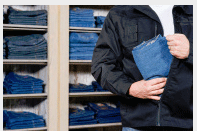Shoplifting during the holidays is a big problem for retailers in the United States. The holiday season brings more customers into their stores, but shoplifters know this and they take advantage of this fact to go into the stores and walk out with hundreds of dollars in stolen merchandise. But after the holidays, you are dealing with another kind of fraud. Merchandise return fraud has seen an increase over the previous year, and retailers now have to deal with this problem after the holidays are over.
For more about this and other topics, follow the links below.
Post-Holiday Merchandise Return Fraud
Retail theft statistics show that the vast majority of returns are legitimate and part of doing business as a retailer.
Returns and return fraud are a big issue—and getting bigger. In 2014, $284 billion worth of retail merchandise was returned in the United States,according to the Retail Equation. That represented a 6.2% increase over the prior year, and 2015’s numbers are expected to grow even higher. Brick-and-mortar stores report returns in the 5-10 percent range. E-commerce retailers report numbers averaging 10-15 percent, with returns of apparel running as high as 20-30 percent. The research firm IHL Group estimates that, overall, returns cost retailers 4.4 percent in revenue that is lost on items that can’t be resold or must be discarded.
Within the retail loss prevention community, when returns are mentioned, most focus on return fraud. To be sure, it is a huge issue with volume estimated at $9.1 billion, again according to The Retail Equation. When return abuse is added in, that number jumps to an estimated $15.9 billion. But, as large as these numbers are, it is estimated that return fraud and abuse only make up about 6.1 percent of returns. So 94 percent of all return transactions (equating to $245 billion) are legitimate.
Retailers Estimate Holiday Return Fraud Will Cost Them $3.8 Billion, According to NRF Survey
WASHINGTON, December 19, 2014 – Techniques and processes put in place to thwart criminal activity around retailers’ return policies continue to be put to the test, and with steadily improving retail sales, even more is on the line when it comes to losses from return fraud.
According to the National Retail Federation’s 2014 Return Fraud Survey* completed by loss prevention executives at 60 retail companies representing grocery, department, discount, specialty and small retailers, the industry will lose an estimated $10.9 billion to return fraud this year. Additionally, of those surveyed, retailers estimate $3.8 billion will be lost to return fraud this holiday season alone, up slightly from last year’s $3.4 billion. Overall, retailers polled estimate 5.5 percent of holiday returns are fraudulent, similar to last year’s 5.8 percent.
“Today’s sophisticated technology does well keeping criminals at arm’s length but often isn’t enough to completely stop the unethical practices of organized and individual retail fraud occurrences,” said NRF Vice President of Loss Prevention Bob Moraca. “Return fraud has become an unfortunate trend in retail thanks to thieves taking advantage of retailers’ return policies to benefit from the cash or store credit they don’t deserve. Additionally, many of these return fraud instances are a direct result of larger, more experienced crime rings that continue to pose serious threats to retailers’ operations and their bottom lines.”
Reflects on How a Shoplifting Charge Changed Her Life
Shoplifting consequences that ended a 35-year career in journalism.
On February 11, 2012, officers of the Tucson Police Department cited former Tucson KVOA news anchor Martha Vazquez on a shoplifting charge. According to the report that was filed, Vazquez was cited for shoplifting at the Dillard’s in the Tucson Mall after a loss prevention officer observed her conceal an Eileen Fisher jacket value at $338.00. After she was detained, a search of her belongings also yielded a pair of Kenneth Cole sunglasses valued at $30 that had also been shoplifted.
Vazquez said that after the shoplifting charges ended her 35-year career in broadcast journalism, her life hit “rock bottom.” She resigned her prominent position, sank into a deep depression and left Tucson for Washington State. Now, Vazquez says the time that she spent out of the public eye in Washington after her incident in 2012, was “a healing journey.” She is now back in Tucson; is being treated for depression and says that she wants to help others.


Speak Your Mind
You must be logged in to post a comment.